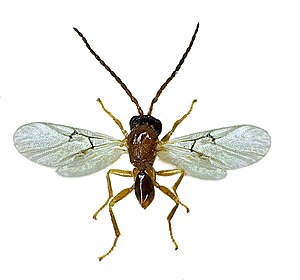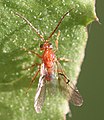Sponge gall wasp
| Sponge gall wasp | ||||||||||||
|---|---|---|---|---|---|---|---|---|---|---|---|---|

Male of sponge gall wasp |
||||||||||||
| Systematics | ||||||||||||
|
||||||||||||
| Scientific name | ||||||||||||
| Biorhiza pallida | ||||||||||||
| ( Olivier , 1791) |
The sponge gall wasp ( Biorhiza pallida ) is a representative of the gall wasps (Cynipidae). The species develops like most gall wasps on oak , whereby it forms typical galls at the point of attachment of the oak leaves as well as at the roots. In these animals, a generation change occurs between a sexual and an asexual ( parthenogenetic ) generation.
features
The gall wasps are three to five millimeters long, the females are larger than the males. They have a brown colored body, with a spherical abdomen . As a result, the winter generation that does not have wings looks very similar to ants .
Occurrence
The sponge gall wasps are common in North Africa , Europe and Asia Minor . They are very common in oak forests.
Way of life
The animals occur in two generations in the year from November to July. The first, wingless generation consists entirely of females. They hatch from December to February from about five millimeters large, lumpy, light reddish galls consisting of a chamber that grow on the roots of oaks. They initially have a soft tissue that later lignifies. Several such galls can also grow together. After hatching, the animals have to run to where they lay their eggs and can then be easily recognized on snow. They are extremely temperature-resistant and are also active at around 0 ° C. They climb oak trees to lay several of their eggs in a bud. A two to three, sometimes four centimeter, potato-like bile consisting of several chambers forms on these buds by June. Their tissue is initially fleshy, later similar to the tissue of mushrooms. From this, the second, winged generation hatches in summer, which now includes males. The females in Northern Europe mostly, if at all, have receded wings, in the Southern European populations they are fully winged. Those of the males are always fully developed. After they have mated, the females dig themselves a maximum of one meter deep into the ground, mainly to lay their eggs on the oak's fine roots.
literature
- Heiko Bellmann : The New Cosmos Insect Guide , Franckh-Kosmos Verlags-GmbH & Co KG, Stuttgart 1999, ISBN 3-440-07682-2
Web links
- Biorhiza pallida (Oliv.) Sponge gall wasp, Potato gall wasp ( Memento from July 4, 2008 in the Internet Archive )










